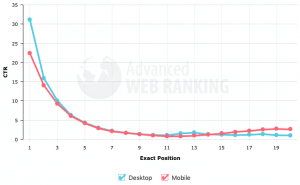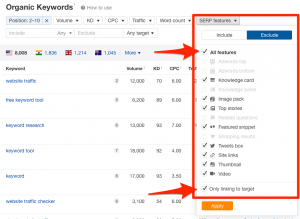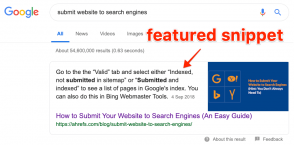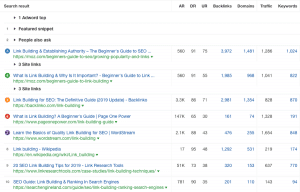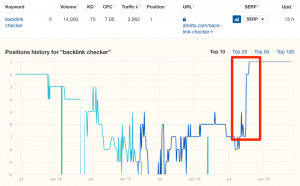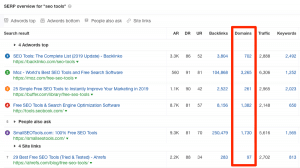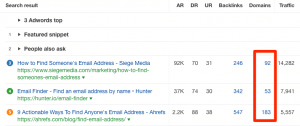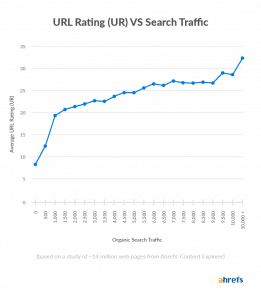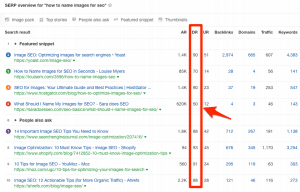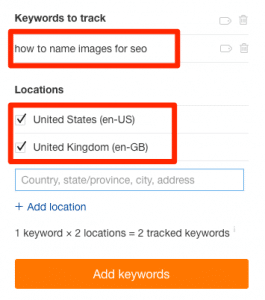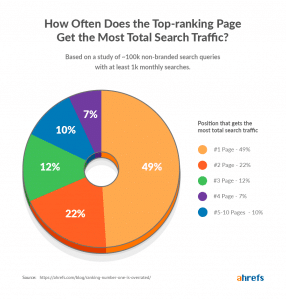How to Rank Higher on Google (6 Easy Steps)

I know this because I’ve been there many times.
Sometimes it feels like no matter what you do, nothing works. Google seems to hate your website, and you have no idea why.
If that sounds all too familiar, then you’re in the right place.
In this article, I’ll run through a systematic and straightforward way to improve your Google rankings and get more traffic.
Here’s the basic process:
- Find the keywords for which you have lackluster rankings.
- Figure out why the other pages are outranking you.
- Beat those pages on those points.
- Rinse and repeat.
Let’s dive straight in.
Step 1: Find the keywords for which you have lackluster rankings
Most SEOs preach finding your page two rankings, then trying to push them to page one.
That seems logical, but there are two reasons why this isn’t a great idea:
- It’s not always easy to improve rankings by 10+ spots.
- Merely ranking on page 1 shouldn’t be your goal if you want more traffic.
That first point should be pretty self‐explanatory. Think of it like this:
It’s easier to win the match from two goals behind than it is from ten behind.
As for that second point, take a look at the average CTR curve for the first couple of pages of Google results:
You can see that the clickthrough rate decreases exponentially as you go down the ranks.
This means if you can move up the ranks by just one position from #5 to #4, you’ll see a bigger traffic increase than moving up ten positions from #20 to #10.
It’s not a small difference either!
If your primary target keyword gets 10,000 searches per month, then the numbers look roughly like this:
Position #5 → #4 = +210 visitors/month
Position #20 → #10 = +8 visitors/month
This is based on average CTR. In reality, this differs on a keyword by keyword basis.
So, what you need to do is find the keywords for which you already rank on the first page in positions #2-#10 and focus almost exclusively on these.
To do this, paste your domain into Ahrefs Site Explorer, go to the “Organic Keywords” report, then filter the report to show only the keywords for which you currently rank in positions #2–10.
Site Explorer > enter domain > Organic search > Organic keywords > add filter
Finally, as you only want to see “true” rankings, exclude all owned SERP features using the SERP features filter. Just click the dropdown, hit “Exclude,” select “All features,” then tick the “Only linking to target” box.
Step 2. Choose a keyword for which you want to rank higher
Every keyword in this filtered report is one for which you already rank, but not in pole position. That means there’s still room for improvement.
The next step is to skim this list for keywords that you most want to improve rankings for.
Having said that, there’s no point chasing rankings for low‐value keywords, or those that are likely to be difficult work. So here are a few things to look for to identify the best candidates.
a) Keywords that already drive the most traffic
Generally speaking, keywords nearer the top of this report are the best targets if your goal is to maximize organic traffic.
That’s because they already drive the most traffic to your website.
Here’s the filtered report for the Ahrefs blog:
If you pay attention to the “traffic” column, you’ll see that there are a handful of keywords that already drive tons of traffic to our posts despite our less than perfect rankings.
Given that improving rankings by just one position can increase CTR by up to ~93% on average, we wouldn’t need to rank much higher for these keywords to drastically increase traffic.
b) Keywords with high search volumes
Improving rankings by just one position can almost double the traffic you get from that keyword. But double nothing is still nothing.
So check the “Volume” column to make sure that the keyword has search volume.
c) Keywords with low KD scores
Keyword Difficulty (KD) is our proprietary keyword difficulty score. It runs on a scale from 0–100 with those at the higher end typically being harder to rank for than those at the lower end.
In other words, it usually takes more effort to rank for a KD50 keyword than a KD20 one.
For that reason, it’s worth skimming the KD column in the report and prioritizing those with a lower KD score.
d) Keywords with high business value
There’s no point driving more organic traffic to your website if it doesn’t translate into more revenue.
That’s why it’s essential to always prioritize keywords with business value.
To illustrate this concept, imagine that you run a bakery in New York.
Ranking #1 for the keyword “New York bakery” is almost certainly going to drive more business than ranking for “cupcake recipe.” Reason being, those searching for the former are more likely to become paying customers.
Thus, “New York bakery” has more business value for you than “cupcake recipe,” despite the latter having 7x more search volume.
e) Non‐branded keywords
I’m not talking about your branded keywords of your own here but rather those of third‐parties.
For example, one of our posts on the Ahrefs blog ranks for “google keyword planner” in position #6.
On the surface, this looks like a good keyword for which to try to improve rankings. However, if we hit the “SERP” dropdown to view the current top‐ranking pages, we soon realize that this isn’t the case.
Most of the pages that rank above us are from google.com.
That’s because this is a branded keyword as the Keyword Planner is a free keyword research tool from Google.
No matter how much effort we made, chances are we’d never outrank Google for this query.
f) Keywords without SERP features in the positions above you
Sometimes Google shows SERP features like featured snippets and “People also ask” boxes in the search results.
In Ahrefs, we count these features as having a ranking position.
For example, our guide to using Google Trends for keyword research ranks in position #4 for “how to use Google Trends,” according to Ahrefs.
But if you hit the SERP dropdown and look at the top‐ranking pages, you’ll see that it’s only SERP features that rank above us.
Now, it is possible to rank for some of these SERP features, but that’s a whole different ball game. So I recommend that you keep things simple and not chase rankings for any such keywords for now.
Step 3. Figure out why you’re being outranked
One web page can outrank another for hundreds of reasons, but don’t let that discourage you.
Many people (including us) have studied various “ranking factors” on numerous occasions and found three things to correlate highly with rankings and traffic time and time again:
- Number of referring domains
- Page authority
- Website authority
But before we get to those, there’s an even more significant ranking factor that you need nail if you’re to have any hope of ranking higher.
Searcher intent
Google’s aim is to provide the most relevant result for any given query. Their entire business model relies on them being able to do this, consistently, across hundreds of billions of searches. For that reason, they’ve invested heavily into understanding the intent of queries, i.e., the reason a person typed a specific thing into Google in the first place.
This is why none of the top‐ranking pages for “link building” are from companies offering link building services, but rather informational blog posts and guides:
Google knows that people who search for link building are looking to learn, not buy.
What does that mean for you? It means that if your page doesn’t align with search intent, you’re dead in the water before you even start.
So how do you decipher the intent behind the search?
The best and quickest way is to analyze the current first page of results for what we like to call the three C’s of searcher intent:
- Content type
- Content format
- Content angle
1. Content type
The content type can usually be divided into four buckets: blog posts, product, category, and landing pages.
2. Content format
Content format applies more to blog posts and landing pages. A few common blog formats you’ll see are “how‐tos,” step‐by‐step tutorials, list posts, and opinion pieces.
For a landing page, that might be something like a tool or calculator.
3. Content angle
The content angle is the USP of your content. It’s basically a unique hook that sells your page to searchers and entices the click.
.….
Just by matching search intent alone, we’ve seen ranking boosts from position #40 to #6 in just four days.
Matching searcher intent is also the primary reason we’re able to rank #1 for the keyword, “backlink checker.”
Bottom line: If your content doesn’t align with searcher intent, then you should fix that before doing anything else. Otherwise, you’ll be fighting a losing battle.
Now let’s take a look at those more “traditional” ways to rank higher.
a) Number of referring domains
We studied almost one billion web pages and found a clear correlation between the number of referring domains pointing to a page and its rankings.
Generally speaking, then, getting backlinks from more referring domains should help you climb the ranks. So what you need to do is look at the SERP and eyeball the number of referring domains to the pages that outrank you.
To do that, hit the “SERP” dropdown in the “Organic keywords” report for your chosen keyword. Look at the “Domains” column.
For example, you can see in the screenshot above that we rank in position #7 for “SEO tools” with 97 referring domains.
But the pages that rank above us 3–34x this amount!
This is a clear indication that we need links from a lot more unique websites to rank higher.
If you look at the same thing for the keyword “find email address,” you can see that we have links from more referring domains than any of the other top‐ranking pages:
… yet we still rank in position #5. (Or #3, if you exclude SERP features.)
This indicates that the sheer quantity of referring domains to the page isn’t the problem here.
Something else is holding us back in the ranks.
b) Page authority
Google’s ranking algorithm is built on something called PageRank, which effectively measures the “backlink authority” of web pages.
But unfortunately, Google discontinued public PageRank scores in 2016. Now there’s no way to see the PageRank of a web page.
Luckily, we at Ahrefs have a similar metric to PageRank called URL Rating (UR).
Much like PageRank, URL Rating takes into account both the quantity and quality of backlinks, as well as internal links to the page. It runs a scale from 0–100.
Here’s how UR correlates with organic search traffic:
So, generally speaking, pages with more “backlink authority” tend to rank higher and get more traffic.
Therefore, you shouldn’t only analyze the number of referring domains to the top‐ranking pages, but also the UR of the pages that outrank you.
To do that, look at the “UR” column in the SERP overview for your target keyword.
In the screenshot above, you can see that the two pages outranking us for “keyword research” have much higher UR scores in comparison.
So we may need to work on this if we’re to rank higher for this keyword.
c) Website authority
Google continues to give mixed signals regarding “website authority” as a ranking factor.
So what’s the real answer?
At Ahrefs, we have our own “website authority” metric called Domain Rating (DR), and we’ve found that this does correlate with rankings, albeit not as strongly as other metrics.
Furthermore, I think most SEOs would agree that Google seems to favor websites with high authority for some queries more than others.
Take the keyword “designer dresses,” for example:
The average DR of the top‐ranking pages is 80.4, and the “weakest” site in the SERP is DR74.
Whether this is because searchers expect to see big brands ranking for this query, or because Google uses website authority as a ranking factor, or both, is unclear.
But what is clear is that you’re probably not going to rank for this particular keyword unless you’re a big, well‐known brand with a lot of “authority.”
So, with that in mind, it’s worth eyeballing the DR of the sites currently ranking.
What you’re looking for is some indication that this isn’t just a keyword for “big players.” If you see one or more websites ranking above you with DR that’s not all too different from your site, then that’s a positive sign—you may very well be able to rank higher.
However, be aware that sometimes, the only way to rank a less authoritative site for a keyword is to create a more specific and focussed article.
You can see an excellent example of this for the keyword, “how to name images for SEO.”
Most of the top‐ranking pages belong to high‐authority websites, but there’s one outlier—a page from a DR50 website in position #5.
This page also has fewer referring domains and a lower UR score than the other top‐ranking pages.
It appears that the reason this page from a little‐known website is able to rank amongst the bigger players is that the content itself is more focussed. It talks about how to name images for SEO, whereas most of the other pages are more general guides to image SEO—which all presumably mention the importance of naming images correctly, amongst other things.
So, as always, this is not an exact science. You need to use your intuition and make your best assessment of whether the authority and popularity of a site matters for the keyword you’re targeting.
Step 4. Beat the other pages where it matters
You should now have some idea as to why you’re being outranked, so the next task is to plug those holes.
Here’s a simple guide to doing that:
If the number of referring domains is the main issue
Build more high‐quality links to your page. It’s as simple as that.
There are tons of ways to do this: guest posting, replicating your competitor’s links, “skyscraper” link building, pursuing unlinked mentions, etc.
If page authority is the main issue
You have two options:
- Build more page‐level backlinks (see above)
- Add “powerful” and relevant internal links to your page
Generally speaking, adding internal links is the quickest and best option if it looks like your page may only need a small boost. Whereas building more backlinks is in order if your page authority (URL Rating) is really suffering.
Of course, you could do both.
If website authority is the main issue
This is the hardest one to solve because it takes the most time.
If your DR pales in comparison to the pages that outrank you, then it may be best to move on to an “easier” keyword.
Having said that, it’s often possible to crack the SERP by winning at the page‐level.
That means either building more internal or external backlinks to your page.
Plus, if you can do that consistently over time, your DR will improve as a natural byproduct of your efforts. Generally speaking, that will increase your website’s ability to rank for more competitive keywords across the board.
You may also want to consider creating a “linkable asset” to improve DR, then you can use internal links to point some of the resulting “authority” directly at the page for which you want to improve rankings.
There are literally hundreds of ranking factors, so these aren’t the only three things that can affect your ability to rank. They’re merely the things that we and many others have found to correlate most highly with rankings.
You should also make an effort to master your on‐page SEO, create a great user‐experience, have a fast‐loading site, etc.
Step 5. Track rankings
It goes without saying that if your goal is to rank higher on Google, then you need to track your rankings. Otherwise, you have no way of knowing whether your efforts are moving the needle.
For that, you need a rank tracking tool like Ahrefs Rank Tracker.
You can track up to 10,000 keywords in Rank Tracker (depending on your plan). We usually just track the primary target keyword for each page.
To set up your keywords in Rank Tracker, select a project, hit “Add keywords, paste or type the keywords you want to start tracking, select the countries you want to track, then hit “Add keywords.”
Rank Tracker > Project > “Add keywords” > enter keywords > Select tracked countries
That’s it. Your rankings are now being tracked.
Hit the graph icon next to any keyword in Rank Tracker to see its ranking progress over time.
Step 6. Rinse and repeat for other keywords
Ranking high for one keyword is great. But ranking high for many is even better.
So once this process works for one keyword, go back to step one and repeat the cycle from start‐to‐finish. Then do it again, and again.
In time, you’ll rank high for hundreds of keywords and get tons of organic traffic every month, just like us.
But before you get too obsessed over your rankings, consider this…
Rankings are overrated; traffic is what counts
We analyzed the top 10 pages for more than 100,000 keywords and found that the top‐ranking result gets the most organic traffic only 49% of the time.
So, believe it or not, SEO isn’t all about ranking #1 for your target keyword.
To illustrate why this is the case, take a look at the SERP for the keyword, “keyword research.”
You can see that despite only ranking in position #3, our page gets 3–7x more organic traffic than the two pages that outrank it!
This happens for two main reasons.
The first is that our page ranks for more keywords than those other two pages—over 2,600 in total! (You can see this by checking the “Keywords” column in the SERP overview above.)
The second is that some of the other keywords for which we rank have very high search volumes, meaning we get tons of traffic from those keywords too.
In fact, that page’s third‐place ranking for “keyword research” is only responsible for around 6.4% of its US organic traffic.
The other 92.5% (17k+ monthly visits!) comes from other keywords.
So, how can you do the same and get tons of traffic from potentially thousands of keywords?
- Cover your topic in as much depth as possible
- Create an “authority” page on your topic
- Nail search intent
- Try to win featured snippets
Final thoughts
Ranking higher on Google isn’t rocket science. But doing so for some keywords is more challenging than others. That’s why it makes sense to chase rankings for uncompetitive keywords for which you already rank on the first page.
It’s then just a case of figuring out why you’re being outranked and doing everything in your power to fix those issues.
